2013 is shaping up as an exciting, groundbreaking year for camera technology and workflows, as users itch to put 4K acquisition to the test on a large scale. There were more 4K workflow solutions on the show floor than ever before — including the first products to support 6G-SDI, many of them from Blackmagic Design — but some camera-makers are sticking with HD and 2K acquisition for the time being. Here's a round-up of what's new so far this year in pro cameras.

ARRI
ARRI used the show as an opportunity to showcase its new Alexa XT series, which replaced most of the pre-existing Alexa line-up, except for the original camera. The Alexa XT, XTM, XT Plus, and XT Studio feature the XR Module developed with Codex Digital, which enables on-board ARRIRAW, ProRes, and (by year's end) DNxHD recording at up to 6.7 Gb/sec. They also have the IFM-1 internal filter module, which allows the cameras to be rated at EI 800 in bright sunlight, as well as high-speed shooting and anamorphic de-squeeze options. But ARRI held the line on 2K acquisition for another year, insisting that images derived from the camera's 3.5K sensor more than hold their own when upresed on a 4K display.
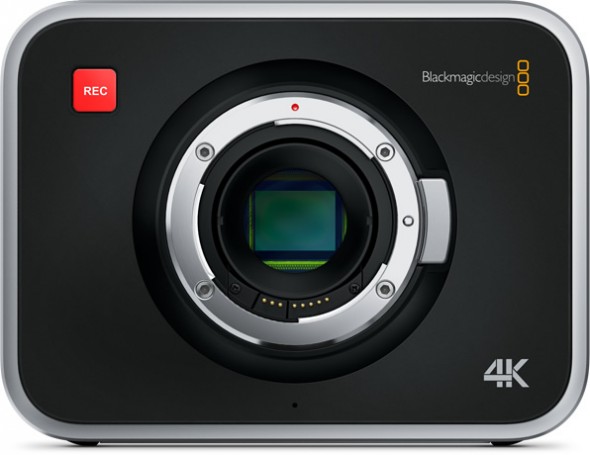
Blackmagic Design
Blackmagic Design came on strong at NAB, nearly eclipsing the popular Blackmagic Cinema Camera (BMCC) with news of the $3995 Blackmagic Production Camera 4K, not to mention the surprise announcement of the Blackmagic Pocket Cinema Camera, a camera with a Super 16 sensor size, a Micro Four Thirds lens mount, and a slim form factor that resembles a point-and-shoot still camera more than a digital cinema camera with raw recording capabilities and 13 stops of dynamic range. Even the price of that one is small — $995. Both of the cameras record to a CinemaDNG raw format that Blackmagic calls visually lossless as well as Apple ProRes 422 HQ. While the Pocket records to SDXC cards, the 4K camera writes to a removable SSD and boasts a 6G-SDI output for single-cable Ultra HD or HD output. Both of the cameras are slated for shipment in July (we checked at press time to make sure the date hadn't slipped) and Blackmagic's credibility as a camera supplier rests in no small part on its ability to make that date. Would-be BMCC users spent the second half of 2012 cooling their heels after an abortive launch, when BMCC realized the sensors in the cameras weren't up to snuff and halted production to work out the issue with its supplier before shipments resumed in 2013.
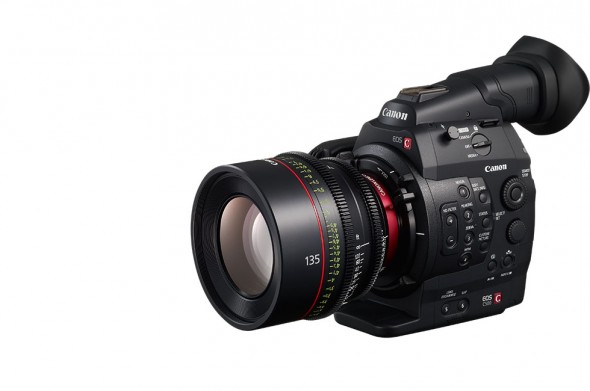
Canon
Canon didn't have any major camera announcements at the show, but with the EOS C500 shipping late last year, the company emphasized that camera's quality and flexibility, positioning it as more than just a capable 4K digital cinema camera. Canon showed the camera recording 10-bit 4K raw via the forthcoming Convergent Design Odyssey7Q recorder, but also talked up what Canon's Larry Thorpe referred to as "Super 2K" capabilities. The C500 is broadcast friendly because the camera's raw 30fps 4K signal is delivered over a single 3G-SDI output that conforms to SMPTE's 425M multiplexing standard, allowing existing broadcast equipment to accept the Canon signal. As a result, Thorpe told us, broadcasters have been experimenting with shooting 4K and using the full-raster signal as a source for selectively cropped and digitally zoomed shots that show instant replays with high clarity at HD resolutions.
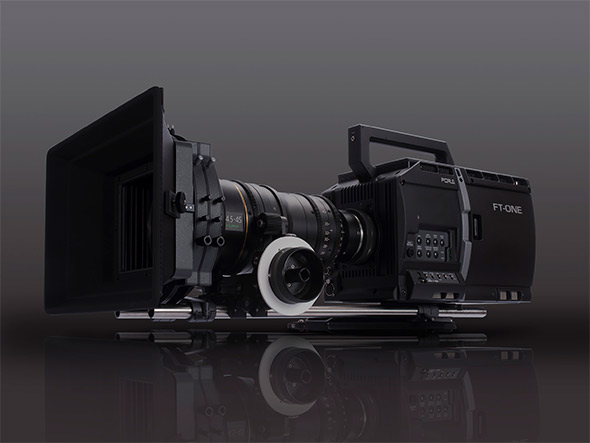
FOR-A
FOR_A announced its FT-ONE 4K super-slow-motion camera (up to 900 fps) at Cine Gear Expo last year and brought it to NAB for the first time in 2013. The camera records 10-bit raw video to RAM, which is then transferred to SSD cartridges. The SSDs can be mounted to an NLE via FOR-A's FT-1READ converter, which outputs the frames in DPX format. The camera’s internal memory can hold just 8500 4K frames at a time (that’s 9.4 seconds of 900 fps footage), but each of two hot-swappable SSD cartridges can hold about nine times as much (up to 84 seconds of 900 fps 4K material). The company rates the camera at 11 stops of dynamic range.
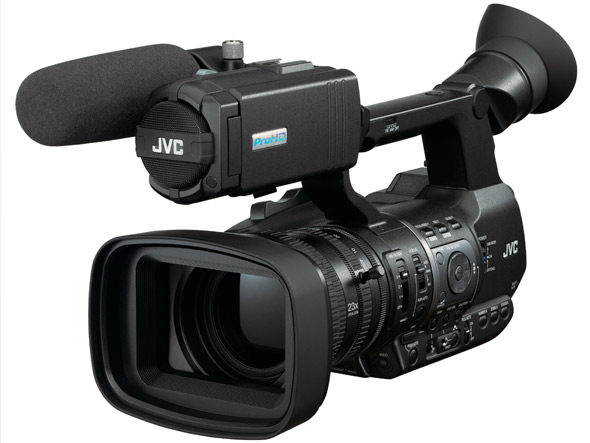
JVC
JVC highlighted an upgraded version of its GY-HM650 ProHD news camera, with its built in FTP and Wi-Fi capabilities. With a 4G LTE modem connected, the camera streams live video transmissions in the background as the camera operator continues to record full-resolution footage. The HM650 has a 23x Fujinon wide-angle zoom lens and records XDCAM EX, Final Cut Pro, AVCHD, and MXF files and supports video streaming of 1080i (3 or 5 Mbps), 720p (1.5 or 3 Mbps), and 480i (0.8 Mbps) video, independent of the recording mode.
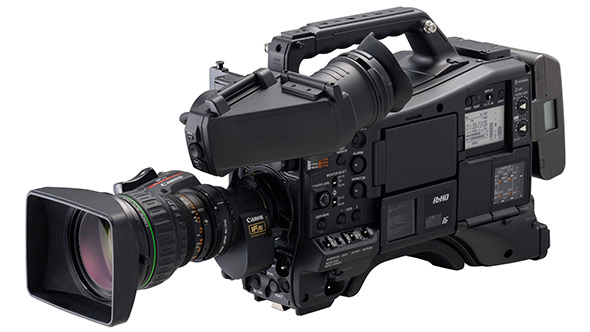
Panasonic
Panasonic declined to offer a 4K camera this year, opting instead to debut one more 1080p VariCam. The so-called VariCam 3 will record at up to 120fps with exceptional quality, thanks to a Log recording option as well as support for new codecs from the AVC Ultra family, including the 12-bit AVC-Intra Class 4:4:4. Some users razzed Panasonic for failing to join the 4K camera party, but the company is betting that the huge universe of users still delivering at HD resolutions — and looking to get more mileage out of all their 2/3-inch glass — will find a solid VariCam with outstanding 1080p performance to be an attractive upgrade. Then again, the VariCam 3 isn't expected to ship until early 2014 — the company obviously changed its mind after floating a 4K VariCam at last year's NAB. Maybe it will change it back before the VariCam 3 actually ships. Stay tuned.
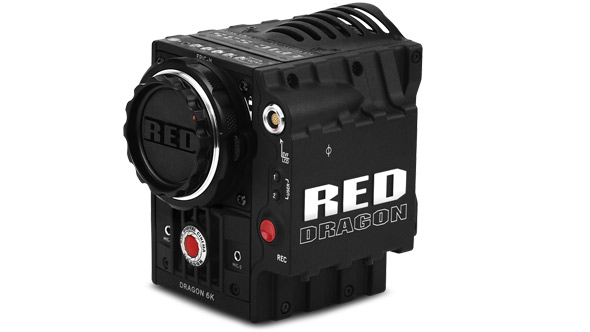
Red Digital Cinema
Red announced an upgrade program allowing current users to upgrade their Scarlet and Epic cameras to the 6K Dragon sensor, the latest and greatest out of the Red labs. Dragon has more advantages than just its pixel count — the company promised more advanced color science, higher dynamic range, and the ability to shoot at up to 100 fps at full resolution. (Scarlet owners are limited to a maximum framerate of 60 fps at 5K, but Red is also offering a trade-in program that gives Scarlet owners a discounted path to full-scale Epic-X Dragon ownership.) The Dragon sensor also draws less power than the existing sensors, but the image-processing hardware required to take advantage of it use a little more, so the result should be close to a wash, Red says. But Red is dealing with its own delays related to hardware problems, and it remains unclear when the first users will get the Dragon sensor.
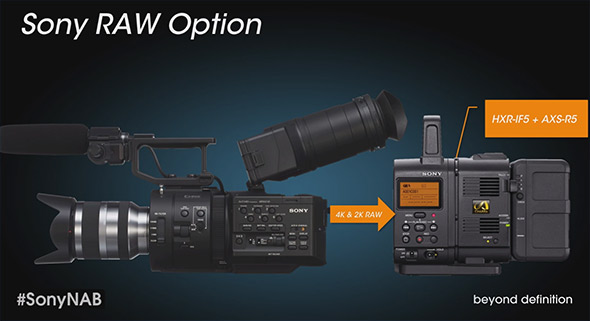
Sony
Sony departed from the typical NAB product cycle last year, when it announced the F5 and F55 cameras in October for a February 2013 ship date. That meant there was no big camera hardware news at NAB, although the company did reveal its plan for 2K raw and 4K recording with the inexpensive "4K-ready" NEX-FS700, which shipped last summer. First, Sony announced the HXR-IFR5 interface unit, which connects the AXS-R5 raw recorder to the FS700 via a single BNC connector and allows recording record 2K 16-bit linear raw at up to 240fps continuously, or 4K at 120 fps for up to four second bursts. The AXS-R5 recorder is available now for a list price of around $6300, and the HXR-IFR5 is due in June (price tba). Another option is Convergent Design's Odyssey7Q, a combination monitor and SSD recorder that supports HD and 2K recording at up to 240fps (.dng) and Ultra HD and 4K recording at up to 30fps (YCC uncompressed, .dpx). The 7Q lists for $2295, and the FS700 raw recording is an option that can be unlocked for $75 per shooting day, or a one-time fee of $1495. It's expected to ship in August. (See our full coverage for more info on the 7Q.)
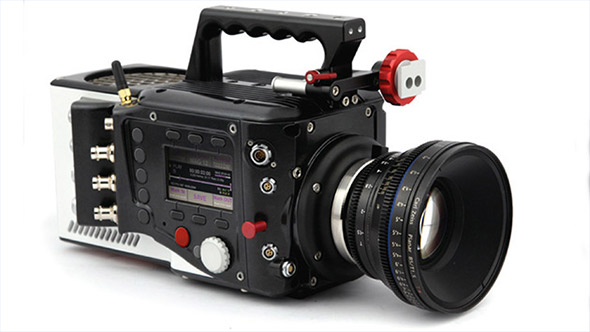
Vision Research
The Phantom Flex4K was one of the stars of the show, boasting up to 1000fps shooting at 4096×2160 resolution, and up to 3000fps at 720p. The Flex4K uses a Super 35 (27.7 x 15.5mm) sensor with a reported 12+ stops of dynamic range and comes with a PL mount. What's more, the company has revamped the Phantom's raw workflow with this camera, which will offer the ability to record compressed files in camera as well as uncompressed raw files and 2x 3G-SDI out. The company cautioned that all of the camera's specs are still preliminary, with the Flex4K scheduled to ship toward the end of 2013.
Crafts: Shooting
Sections: Technology
Did you enjoy this article? Sign up to receive the StudioDaily Fix eletter containing the latest stories, including news, videos, interviews, reviews and more.









Leave a Reply